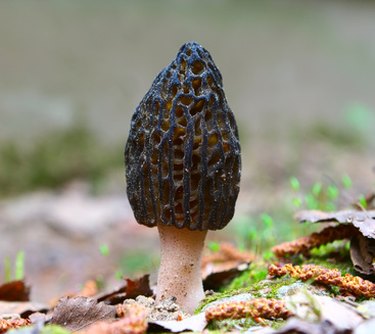
The morel mushroom is one of nature's most sought mysteries. For decades, scientists have studied when, where and how morels grow best, and they've had little success. Although it is known that ground and air temperatures and rainfall amounts affect morel crops, growers still have difficulties cultivating morels. Mushroom hunters are forever hypothesizing on the best places to find morels, but they arrive mostly at theories. It is just this mystery that attracts growers, experts and hunters to seek out the morel.
Types
Video of the Day
North America has three types of morels: yellow, black and half-free. All types are edible. Morels have caps with a textured, honeycombed appearance full of pits and ridges. The center of the morel mushroom is hollow and has one central chamber. Beware of "false morels,” which resemble morels but are actually poisonous. The “early morel,” which resembles the yellow morel, is another poisonous impostor. The online database Index Fungorum suggests that 196 species of morels exist worldwide.
Video of the Day
Habitat and Growing Season
Morels often grow around dead or dying elm and apple trees, sometimes in abandoned apple orchards. They are also frequently found under living ash, tulip, oak, cottonwood and poplar trees. Morels also like areas with exposed limestone. One of the places where the largest number of morels appears is in and west of the Rocky Mountains. Abundances of morels are often found after forest fires that destroyed large areas of timber. Morel fruits appear in springtime.
Hunting
Morel hunting is seen almost as a sport by many enthusiasts. An estimated 50 million people worldwide hunt for morels. In spring, hunters begin searching woods for morels. Finding morels is an incredibly difficult task because their growing conditions are many and varied rather than predictable. Even in locations that are designated as "morel spots” from the previous year offer no guarantee that morels will be found there again. Hunters and experts alike are unsure what make ideal growing conditions for morels. Dried mushrooms can produce 75 percent or more revenue per pound than fresh mushrooms. Their selling price ranges from $20 to $250 per pound. Fresh morels bring in $5 to $50 per pound, a 2005 University of Alaska article states.
Home Cultivation
Many home growers have attempted to cultivate morels because of their high selling price. Growing kits can be purchased, but they are not guaranteed due to the morel’s mysterious growing conditions. Some people say that taking water that morels were washed in and tossing it onto a lawn or compost heap can yield an abundance of morels the next spring. In Canada, where home growing is popular, the economic benefit of growing and harvesting mushrooms was $197 per acre per year, whereas pulpwood's benefit was just $138 per acre per year, according to a 1995 study.
Uses
Morel mushrooms are popular for their strong flavor and are considered a delicacy. From 3 million to 5 million lb. of morels are harvested each year and sold to a variety of distributors. They are often sauteed in butter or olive oil and served with pasta. They also can be frozen and kept for later use. Morel dishes are often found in high-end restaurants.
Precautions
Morels must be cooked completely before eaten. Raw morels are mildly poisonous and can cause sickness. Consulting a mushroom guide or other expert source before eating any mushrooms that are found in nature is advised. While only 5 percent of mushrooms found in North America are poisonous, only 5 percent are considered suitable for eating, too. The remaining mushrooms are considered unfit for eating by most people.
- David Fischer's American Mushrooms: Morel Mushrooms
- University of Wisconsin at Madison: The Morel Life Cycle; Thomas J. Volk
- U.S. Department of Agriculture: Ecology and Management of Morels Harvested from the Forests of Western North America
- University of Alaska at Fairbanks: Morels: A Morsel After the Fire; July 2005
- The Great Morel: Morel Recipes